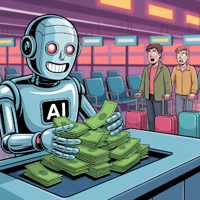Tools & Platforms
4 ways retailers are adopting AI, robotics, and other new tech in 2025

4 ways retailers are adopting AI, robotics, and other new tech in 2025
There have been seismic shifts in how people shop. Customers seek even more convenience, faster transactions, and a personalized shopping experience.
However, data shows that retailers are struggling to meet these consumer needs. According to a 2024 IBM study, only 9% of consumers reported being satisfied with their in-store shopping experiences, while just 14% expressed satisfaction with online shopping.
This is where artificial intelligence has begun to fill the gap. Retailers are rapidly turning to AI-driven technologies to enhance the shopping experience and address these key pain points. In fact, 59% of consumers have shown interest in using AI applications while shopping, while 80% admitted they haven’t yet tried AI-powered shopping tools but are eager to explore them, according to the IBM survey.
As a result, companies are heavily investing in artificial intelligence, robotics, and interactive technologies to bridge these gaps. With AI-powered self-checkout systems that reduce wait times, QR Codes that provide instant product information, and virtual assistants that streamline customer service, retailers are reshaping how people shop, buy, and sell.
With AI adoption within the retail landscape accelerating, Uniqode analyzed industry reports and news articles to explore the latest advancements in shopping technology and what consumers may start encountering as they shop in the future
Delivery robots
Autonomous delivery robots are gaining momentum in major cities like Chicago and Los Angeles as restaurants and retailers look to improve efficiency, cut costs, and meet rising demand for faster, more reliable deliveries.. These robots use advanced navigation systems, cameras, and sensors to safely transport orders from businesses to customers, reducing reliance on human couriers.
In Los Angeles, fast-casual burger chain Shake Shack partnered with Serve Robotics and Uber Eats to offer robot deliveries at select locations. These robots navigate sidewalks using advanced mapping technology to deliver food directly to customers without human involvement.
Globally, in places such as Chicago, Miami, Los Angeles, and Helsinki, Coco delivery robots are helping businesses fulfill local orders using small, wheeled robots that travel on sidewalks. Unlike traditional bike or car deliveries, these robots bypass traffic, lower delivery costs, and improve order fulfillment efficiency. Coco uses QR Codes displayed on the outside of each robot to help businesses accurately fulfill orders.
Coco robots are used in collaboration with companies such as DoorDash, Uber Eats, and OpenAI.
Beyond food delivery, Vayu Robotics has developed an on-road, AI-powered delivery robot designed to operate without expensive lidar sensors, a technology that uses pulses of laser light typically used in drones for aerial and 3D mapping.
Instead, it uses a more affordable vision-based system to transport goods, making last-mile logistics more scalable and accessible for retailers and e-commerce brands.
Drone deliveries
Drones are helping to reduce delivery issues in urban and rural areas, such as traffic congestion, long wait times, and infrastructure limitations. Equipped with advanced navigation systems and AI-powered flight controls, drones can transport goods quickly and efficiently. PwC projected drones will complete about 14,000 deliveries per day, adding up to nearly five million B2C deliveries globally in 2024.
One of the leading players in this space, Zipline, has already completed over 1.4 million deliveries and is rapidly expanding its operations across Africa and the United States. Zipline’s drones use precision airdrop technology to deliver medical supplies, groceries, and retail goods to hard-to-reach locations. This is particularly valuable for health care providers and logistics companies looking to serve remote or underserved communities.
Big-box retailers such as Walmart are expanding their drone delivery networks to offer faster and, in some cases, same-day delivery. Dallas has become a key testing ground city for Walmart’s aerial delivery program, where the retailer has partnered with Wing, Alphabet’s drone delivery subsidiary, to offer same-day deliveries for select products. The drones can deliver small orders, such as groceries, household essentials, and pharmacy items, in as little as 30 minutes, reducing wait times for customers. QR Codes on the ground assist in landing the Wing drones back at home base.
AI-driven shopping
Artificial intelligence is redefining how consumers shop by enabling frictionless checkout, personalized shopping experiences, and smarter inventory management.
Amazon’s Just Walk Out technology uses AI-powered sensors and machine learning to allow shoppers to grab and go without checking out at a register. Purchases are automatically charged to shoppers’ accounts. The technology has been used at Amazon Fresh and Amazon Go stores across the United States, with plans for broader adoption in high-traffic convenience stores and concession areas.
Blockchain platform Pundi X launched PundiPay for merchants. In this system, retailers can generate and display a QR Code that allows customers to pay with crypto on their devices.
With more consumers interested in using AI technology in their retail experience for convenience, many retailers have begun integrating AI-driven technologies to boost customer satisfaction. This includes AI-powered product recommendations, automated restocking, and smarter inventory management.
Spatial computing
Spatial computing merges digital and physical retail spaces to create interactive shopping environments. AI technology leverages augmented reality to provide shoppers with advanced features such as virtual try-ons, AI-powered store navigation, and personalized digital displays that respond to real-time customer behavior.
Millions of Olympics enthusiasts got to experience one such concept at the 2024 Paris Olympics with retail giant Alibaba’s Wonder Avenue pop-up, a 289-foot-long showcase of shopping technology that blends physical and digital experiences. Shoppers went through different areas in the showcase where they could create personal avatars, digitally “try on” products via their avatars to imagine their perfect looks, and even pick out cosmetics and fragrances based on tailored recommendations from a smart assistant.
Other spatial computing applications include AI-powered navigation systems that help customers find store products quickly by providing real-time directions within large retail spaces, such as malls. Interactive digital displays facilitated by QR Codes on products or in catalogs can also help customers design a product they will eventually purchase, such as how Ikea used AR apps to help buyers imagine what furniture and decor will look like in their homes.
These AI-driven technologies are reshaping how customers interact with physical retail environments, blending digital convenience with in-store experiences.
As retailers continue to invest in AI, robotics, and immersive technologies, the lines between physical and digital shopping will only blur further. From sidewalk robots to aerial drones, personalized AI tools to spatial computing experiences, the retail journey is becoming faster, smarter, and more engaging.
In 2025 and beyond, staying ahead means not just keeping up with innovation but reimagining how technology can meet rising consumer expectations at every touchpoint.
Additional research by Emma Rubin and Alizah Salario. Story editing by Carren Jao. Additional editing by Elisa Huang. Copy editing by Kristen Wegrzyn. Photo selection by Lacy Kerrick.
This story was produced by Uniqode and was produced and distributed in partnership with Stacker.
Tools & Platforms
AI anxiety: How technology is turning travel into a trap and what you can do about it – Madison Daily Leader
Tools & Platforms
Egypt’s NTI Partners with Private Sector to Boost AI and Digital Skills

The initiative aims to strengthen capacity building and enhance the qualifications of Egypt’s youth in the fields of artificial intelligence, data analysis, and information and communication technology.
The National Telecommunication Institute (NTI) has signed a cooperation agreement with Data Company – FDSI and Digital Fortress EG as part of the Ministry of Communications and Information Technology’s strategy to prepare young people for the digital job market. The initiative aims to strengthen capacity building and enhance the qualifications of Egypt’s youth in the fields of artificial intelligence, data analysis, and information and communication technology.
Under the agreement, the partners will collaborate on developing training content that meets the demands of both the local and global labor markets. Students and graduates participating in the Digital Egypt Youth Initiative – Ready for Employment program will gain practical training opportunities in realistic working environments within the companies, lasting four months. In addition, vocational training certificates will be provided to participants upon completion.
The collaboration also includes the design and supervision of practical application projects for trainees enrolled in the Digital Egypt Youth Initiative – Career Start program, a six-month initiative focused on preparing young talent for professional careers.
Founded in 1983, NTI operates under the Ministry of Communications and Information Technology and serves as a leading educational, research, and consulting institution, contributing to Egypt’s vision of building a digital society and enhancing technological competitiveness under the Egypt 2030 framework.
FDSI specializes in artificial intelligence applications and data analysis, with a focus on advancing decision-making science across financial services, governance, risk, and compliance. Digital Fortress EG is a major telecommunications and IT company providing integrated solutions and services to support digital transformation and create sophisticated work environments.
This partnership highlights the importance of collaboration between public and private sectors in equipping Egyptian youth with the skills needed to excel in AI, data analytics, communications, and ICT, fostering a digitally skilled generation capable of competing in line with the Egypt 2030 vision.
Tools & Platforms
Why Tech Rotation and Sector Diversification Are Key in 2025

The global equity markets in 2025 have been defined by a paradox: a relentless AI-driven bull run coexisting with growing skepticism about the sustainability of high-growth valuations. The S&P 500’s fourth consecutive monthly gain—capping August with a 2.17% return—underscores this duality. While the index reached record highs, its performance was disproportionately driven by a handful of tech giants, most notably NVIDIA, which contributed 2.6 percentage points to the index’s year-to-date return [4]. Yet, beneath this optimism lies a market recalibrating itself to shifting macroeconomic realities, regulatory pressures, and the inherent volatility of speculative bets.
The AI Bull Run: A Double-Edged Sword
NVIDIA’s meteoric rise in 2025 has been emblematic of the AI hype cycle. Its stock surged 35% in August alone, despite a brief pullback amid broader tech sector jitters [2]. The company’s dominance in AI semiconductors has made it a proxy for investor confidence in the sector’s long-term potential. However, this concentration of returns raises critical questions. As of August, the Information Technology sector’s price-to-earnings ratio stood at 37.13, far above its five-year average of 26.70 [3]. Such valuations, while justified by short-term momentum, expose portfolios to sharp corrections if AI’s transformative promise fails to materialize at scale.
The contrast with underperforming tech stocks is stark. The Trade Desk (TTD), for instance, fell 37% in August 2025, marking a 55.20% total return for the year-to-date [4]. Its struggles—triggered by a Q3 earnings miss, leadership changes, and a P/E ratio of 65.9 (versus the Media industry median of 18)—highlight the fragility of growth stocks lacking durable competitive advantages [1]. Even Intel (INTC), a traditional tech stalwart, exhibited volatility, swinging from a 7% drop on August 20 to a 25% monthly gain by month-end [4]. These swings reflect a sector grappling with supply chain risks, trade tensions, and the challenge of repositioning in an AI-centric world.
Sector Rotation: A Shift Toward Stability
Amid this turbulence, investors have increasingly rotated into defensive sectors. Healthcare and consumer staples, long considered safe havens, have shown relative resilience. The healthcare sector, despite a trailing six-month return of -9.1%, has attracted capital due to its stability during economic downturns [1]. Companies like UnitedHealth have even drawn attention from value-oriented investors, including Warren Buffett’s recent investments [6]. Similarly, consumer staples, with a 12-month return of 15.8%, have benefited from consistent demand for essential goods, even as broader markets fluctuate [1].
This rotation is not merely a defensive play but a response to macroeconomic pressures. Rising interest rates and inflation expectations have made high-growth tech stocks—often reliant on future cash flows—less attractive. The Nasdaq, a growth-oriented index, has fallen over 6% year-to-date in 2025, signaling a broader shift toward value and cyclical stocks [2]. Sectors like financials, energy, and industrials have outperformed, reflecting a market prioritizing earnings visibility over speculative growth [2].
Strategic Asset Allocation: Balancing Growth and Resilience
The 2025 market environment demands a nuanced approach to asset allocation. Overexposure to AI-driven tech stocks, while rewarding in the short term, carries significant downside risk. Conversely, an overreliance on defensive sectors may leave portfolios underperforming in a growth-oriented cycle. The solution lies in diversification: pairing high-growth AI plays with resilient sectors that can buffer against volatility.
For instance, pairing NVIDIA’s AI-driven momentum with healthcare’s regulatory resilience or consumer staples’ consistent demand creates a portfolio that balances innovation with stability. This strategy is supported by historical data: during periods of market stress, defensive sectors have outperformed, while growth sectors have led in expansionary phases. By allocating capital across these buckets, investors can mitigate the risks of sector-specific shocks while participating in long-term trends.
Conclusion
The AI-driven bull run of 2025 is a testament to the transformative power of technology. Yet, as history shows, no sector is immune to the forces of valuation corrections and macroeconomic shifts. NVIDIA’s outperformance and the struggles of TTD and INTC illustrate the perils of overconcentration in high-growth stocks. Meanwhile, the relative strength of healthcare and consumer staples underscores the enduring appeal of defensive assets. For investors, the path forward lies in strategic diversification—a disciplined approach that balances the allure of AI’s potential with the pragmatism of sector resilience.
**Source:[1] Sector Views: Monthly Stock Sector Outlook [https://www.schwab.com/learn/story/stock-sector-outlook][2] The 2025 Stock Market Rotation: What it Means for Investors [https://www.finsyn.com/the-2025-stock-market-rotation-what-it-means-for-investors/][3] Equity Market Resilience Amid Sector Rotation: From AI [https://www.ainvest.com/news/equity-market-resilience-sector-rotation-ai-hype-broader-market-indicators-2508/][4] Big Tech has fueled most of S&P 500 gains in 2025 [https://www.openingbelldailynews.com/p/stock-market-outlook-sp500-investors-fed-rate-cuts-nvidia-microsoft-broadcom-apple]
-

 Business3 days ago
Business3 days agoThe Guardian view on Trump and the Fed: independence is no substitute for accountability | Editorial
-
Tools & Platforms3 weeks ago
Building Trust in Military AI Starts with Opening the Black Box – War on the Rocks
-

 Ethics & Policy1 month ago
Ethics & Policy1 month agoSDAIA Supports Saudi Arabia’s Leadership in Shaping Global AI Ethics, Policy, and Research – وكالة الأنباء السعودية
-

 Events & Conferences3 months ago
Events & Conferences3 months agoJourney to 1000 models: Scaling Instagram’s recommendation system
-

 Jobs & Careers2 months ago
Jobs & Careers2 months agoMumbai-based Perplexity Alternative Has 60k+ Users Without Funding
-

 Funding & Business2 months ago
Funding & Business2 months agoKayak and Expedia race to build AI travel agents that turn social posts into itineraries
-

 Education2 months ago
Education2 months agoVEX Robotics launches AI-powered classroom robotics system
-

 Podcasts & Talks2 months ago
Podcasts & Talks2 months agoHappy 4th of July! 🎆 Made with Veo 3 in Gemini
-

 Podcasts & Talks2 months ago
Podcasts & Talks2 months agoOpenAI 🤝 @teamganassi
-

 Mergers & Acquisitions2 months ago
Mergers & Acquisitions2 months agoDonald Trump suggests US government review subsidies to Elon Musk’s companies






















